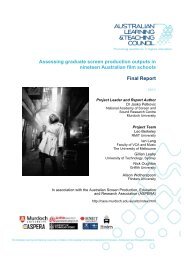PP654 UniSa Freney - Final Report Feb 2010.pdf - Office for ...
PP654 UniSa Freney - Final Report Feb 2010.pdf - Office for ...
PP654 UniSa Freney - Final Report Feb 2010.pdf - Office for ...
You also want an ePaper? Increase the reach of your titles
YUMPU automatically turns print PDFs into web optimized ePapers that Google loves.
During the later half of the project, the frequency of communication reduced due toother commitments of the team members and this adversely affected the cohesion andeffectiveness of the team. It was very difficult to maintain the high levels ofcommunication required over the extended timeframe. The project leader maintainedfrequent communication with the programming team throughout the project to ensure asuccessful outcome. This entailed regular emails and, when necessary, meetings todiscuss issues arising from trials. At this later stage of the project communication withother team members and stakeholders was limited to occasional emails and phonecalls to update them on critical developments.A higher level of communication with a greater number of external institutions wouldhave been beneficial in terms of greater dissemination and validation of the project.Instead the project leader concentrated ef<strong>for</strong>ts on a few key colleagues who had showngreat enthusiasm <strong>for</strong> the project. This was partially due to difficulties with managingworkload over the extended time frame and with the <strong>for</strong>e mentioned technicaldifficulties which prevented external trials and added weight to the decision not toengage with a large number of external institutions.Team MembersThe success of the project can be attributed to high levels of engagement, andcommitment by the team members despite many challenges during the extendedtimeline of the project.A critical factor was the significant commitment given by senior online learning experts,administrators and managers within the university. Their expertise in the developmentof educational software systems was essential to the project leader in terms ofhighlighting critical issues that might otherwise have been overlooked. Theirwillingness to become directly involved with the project via offering in kind services,and accepting the Programmer 2 position (funded by the project) and there<strong>for</strong>ededicating resources (staff) to the programming task was essential to the successfulcompletion of the project.Another success was the working relationship between the external programmer andthe programming staff within the university. Although each had clearly defined roles,there was a high degree of willingness to adjust the roles to meet new technicalchallenges. A high level of cooperation and communication was necessary to ensurethat their work integrated correctly as a whole, and a positive outcome was alwaysachieved albeit with some compromises where necessary.At one point, due to restructuring of the online learning unit in the lead institution, therewas considerable upheaval and delays to the project brought about by staffing changesand this was the basis <strong>for</strong> one of the timeline extensions. A change of managementwithin the unit necessitated new arrangements <strong>for</strong> resourcing the project which lead tosome interruption to the programming task, however an agreement was reached thatwas amenable to all concerned. This required some presentations and discussions withthe new management who were very supportive and cooperative in providing theresources required.Having a team member with an extensive network of contacts in learning and teaching,experience with online learning methods, and general know-how regarding themachinations of research projects, was extremely beneficial in terms of developingstrategies to the approach of the project.Computer Aided Feedback & Assessment System (CAFAS) 36
















